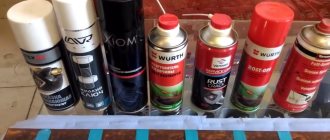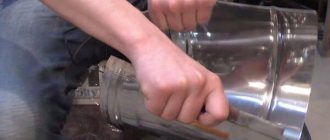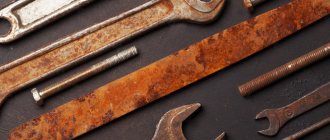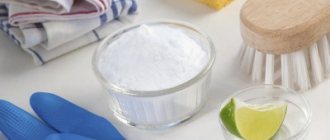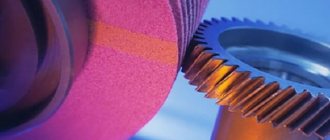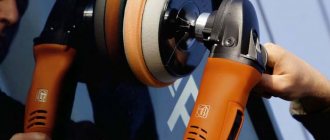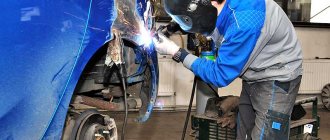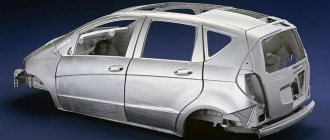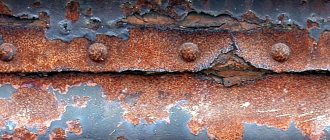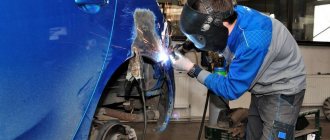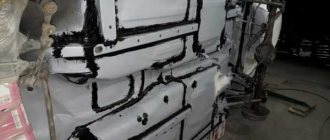The need to prepare metal products for painting is due to an increase in the adhesion characteristics of the substrate to the paint and varnish material and the resistance of the metal to corrosion processes. All this will have a positive effect on the service life of the painted products. However, most owners are much more concerned about the presence of rust, which must be removed during the metal preparation process, than about degreasing, which is why painting work is carried out without this important and mandatory operation.
Corrosion formation
Metal corrosion , or simply rust, appears as a result of metal oxidation under the influence of the environment. The main reason for its appearance is damage to the paint on the car body.
All resulting scratches and chips sooner or later become a source of rust formation, which gradually spreads deeper into the stain and over the entire larger surface area of the body.
The rate at which corrosion spreads depends on the aggressiveness of the environment and the condition of the body itself. For example, in the winter season it spreads many times faster.
It is much easier to deal with a single rust stain that has just appeared than with multiple “saffron caps” or an old stain where the metal is corroded almost completely.
The appearance of corrosion that is not yet visible to the eye is indicated by swelling of the paintwork. Such areas should be immediately cleared of old paint and cleaned.
Types of body corrosion
Among the most common types of body corrosion are:
- Chemical. The main catalyst is the surrounding part. The metal product gradually begins to oxidize. The biggest danger is contact with moisture. After all, it may contain various substances and additives. Even air is chemically dangerous for metal, especially in places with a very poor environment.
- Mechanical. Caused by the impact of significant mechanical load on the body. This process especially often manifests itself along with electrochemical corrosion, in places of mutual contact and connection of materials.
- Electrochemical. The likelihood of such body corrosion developing is especially high during the cold season. This is due to the fact that there is a lot of salt, sand and other reagents on the road. In contact with steel, they create a cathode-anode connection. As a result, the metal surface quickly deteriorates.
Vulnerable places
The areas that experience the greatest mechanical stress are the most susceptible to corrosion. These include:
- thresholds are among the first to suffer from corrosion;
- hood – small pebbles from the vehicle in front provoke the appearance of numerous chips;
- wheel arches are constantly exposed to aggressive chemicals.
It is important to promptly detect emerging rust and eliminate it, preventing the further spread of corrosion. To do this, you need to know how you can deal with this unpleasant phenomenon yourself.
Corrosion Removal Methods
Corrosion can be eliminated in the following ways:
- Mechanical – used for severe corrosion, it involves removing rust by stripping down to metal, followed by priming, puttying and painting the area of the body being repaired;
Advantages of the method: elimination of large and deep stains, damage under swelling paint, as well as low cost and availability of the necessary materials.
Disadvantages: length of the process.
- Chemical - involves using rust removers. Such reagents are widely represented on the modern market.
Advantages of the method: elimination of corrosion in hard-to-reach places, higher process speed.
Disadvantages: inability to use on heavily damaged areas.
Let's consider the process of eliminating corrosion using each of the methods presented above in more detail.
Types of processing of rusty metal surfaces
The choice of rust treatment method depends on the degree of corrosion and the type of item itself. It is also necessary to consider what metal care products are available and available for use.
The most common processing methods include:
- Chemical.
- Mechanical.
- Thermal. It is carried out using a torch.
Rust cannot be removed by washing with plain water. For this purpose, targeted, comprehensive processing is required.
You will find all the most useful and important information about rust removal methods and techniques in this section.
Thermal
The thermal method is rarely used . The use of an oxygen-acetylene torch makes it possible to remove mill scale well, but does not completely remove rust.
Burners must be used under suitable conditions. Despite the high traumatic nature of the method, its effectiveness is inferior to chemical treatment.
Mechanical
Physical impact on rust is designed to remove the top layer of material that has become loose. This can be done in several ways:
- manually (using a brush with metal bristles and scrapers);
- using a grinding machine or a special machine.
In addition to those products that are available at home, industrial enterprises also use serious devices using special equipment to treat rust:
- shot blasting;
- water sandblasting;
- sandblasting
The best result is obtained by a combination of abrasive and chemical effects.
Chemical
Chemical treatment is carried out using homemade products and purchased, ready-to-use preparations. In addition, large metal surfaces are also subjected to special influences that help preserve and protect the material:
- connection with organic additives, providing bluing;
- cementation - a chemical reaction with carbon;
- nitriding, etc.
The chemical method allows you to remove rust through a chemical reaction using substances that are active against corrosion products.
Treatments carried out at home include:
- preparation of material;
- exposure to a chemical;
- wash.
The type of chemical exposure must take into account the degree of damage to the metal.
Step-by-step instruction
Before starting repair work, it is necessary to inspect the body and identify all problem areas. Assess the degree of damage and decide on a method to eliminate corrosion.
Tools and materials
Before starting work you need to prepare:
- grinder;
- sandpaper;
- degreaser;
- putty;
- primer;
- paint;
- car varnish;
- rust converter;
- masking tape;
- clean cloth.
Popular drugs
The most popular chemicals for removing rust from a car body with your own hands are:
- orthophosphoric acid is the most well-known remedy; it can be used in its pure form or be part of various chemistry;
- VSN-1 Neutralizer - easily copes with rust, turning it into a dark mass;
- zinc – a kit for removing rust and further galvanizing the metal by applying a special protective layer using an electrochemical method. Requires connection to battery. The process of working with the Zinkor product can be seen in detail in the video clip:
Often, car owners want to quickly and without unnecessary hassle remove visible traces of corrosion from the car body. In this case, you can use special products, such as Anti-Rust paste.
It will quickly eliminate noticeable rust marks from the surface of the body, but will not eliminate the source of the spread itself. Therefore, this effect will last no more than a month. As a rule, owners resort to this method during pre-sale preparation of the car.
Mechanical method
Removing rust stains mechanically is carried out in several stages:
- cleaning corrosion down to metal with sandpaper. The work can be done manually or using a power tool, such as a grinder. The stain should be cleaned gradually and carefully, avoiding rough scratches. It is important not to damage entire areas of the paintwork and to carry out 100% complete stripping down to “bare” metal.
- treating the prepared area of the body with a rust converter in order to eliminate the smallest corrosion residues that are not always visible to the eye.
- degreasing the surface after the converter ends (on average after half an hour);
- putty (carried out in several layers if necessary) and grinding of the treated surface;
- painting in body color (before painting, protect adjacent parts of the body with newspapers and masking tape and apply an anti-corrosion primer in 2-3 layers). Painting is also carried out in 2-3 layers, each thoroughly drying.
- application of clear varnish (if desired) for more reliable protection and a beautiful appearance.
The result of the work will depend entirely on compliance with all instructions and the correct execution of the work. If the technology is violated, for example, due to poor-quality cleaning or insufficient drying, the result of the work may be completely short-lived.
Watch a video on how to remove rust from a car in 10 minutes:
Chemical method
The significant difference between this method and the previous one lies only in the first stage - cleaning from rusty stains. Instead of mechanical cleaning, specialized chemicals are used. It can remove rust and prevent its further spread without damaging the metal.
As a rule, such preparations are applied to the problem area in accordance with the manufacturer's instructions for the specified time, after which the remaining product is wiped off or washed off.
However, to obtain an excellent and long-lasting result, you will also have to putty, sand and paint. When eliminating minor damage to the body, you can do without these steps.
How to quickly remove rust from a car - electrochemical method
The electrochemical method of removing rust from a car body involves performing an oxidation-reduction process on the affected area. The reaction itself takes place in an electrolyte under the influence of current. This is a complex process. But if you look at it, it turns out that this is the simplest method of getting rid of corrosion.
Advantages of the method:
- Complete rust removal.
- Availability and simplicity.
- Formation of a zinc layer to protect the metal in the future.
- The method is harmless to undamaged paintwork.
- Quick results.
For the procedure you will need:
- A piece of metal wire.
- Two stainless steel electrodes (one with a zinc tip).
- Corrosion converter.
- Zinc chloride solution.
To remove rust you need:
- Connect the wire to the positive terminal of the battery.
- Make a cotton tip on the tip of the electrode and dip it into the transducer.
- Carefully apply the tip to the area damaged by rust.
- Connect the second electrode with a zinc tip to the battery cable instead of the first electrode.
- Make a fabric wrap around the zinc tip.
- Dip the electrode into the zinc chloride solution and run it over the cleaned area of the metal to create a protective layer.
Recommendations
To ensure that rust treatment on metal is as productive as possible, you must adhere to the following recommendations:
- The corrosion process begins from the most vulnerable areas. Its spread can be prevented by cleaning and creating a protective coating.
- When carrying out rust removal work, personal protective equipment must be used.
- When working with purchased products, rust converters, you must first study the instructions for the selected product and strictly follow them.
- Even expensive rust converters are not able to restore metal if it has very significant damage, for example, through corrosion.
- Preventing rust will help keep your metal products in good condition.
- The most reliable protection of metal is its galvanization. The use of products containing zinc helps prevent corrosion.
Metals that do not contain alloying elements are more susceptible to corrosion.
The best corrosion converter sprays
The most popular form of release of corrosion converters is sprays.
WURTH
This German product is made using special chemicals. It is easy and convenient to apply even in hard-to-reach areas. After all, there is a long nose here. This converter has excellent penetrating ability, it is perfectly absorbed and instantly dissolves rust.
WURTH protects against further damage and is suitable for all metal surfaces.
Advantages:
- Excellent penetrating ability.
- Squeezes moisture out of electrical contacts.
- Formation of a protective layer.
Flaws:
- High price.
- Very flammable, you have to be careful.
KUDO
This product is made on an acid basis. KUDO deeply affects rust, removes it and protects it from secondary appearance. After treatment, a film is formed on the surface, which reliably protects the car body from subsequent negative influences. The converter has a lasting effect and is not washed off after treatment.
Advantages:
- Quick and easy application.
- Affordable price.
- Dries quickly.
- No smell.
Flaws:
- There is no embossing effect promised by the manufacturer.
Hi-Gear Rust Treatment No-Rust
This is one of the most famous and popular converters among domestic drivers. This is due to the fact that the product contains quite aggressive components. They quickly eat away rust and turn it into soil. Hi-Gear Rust Treatment No-Rust comes in an aerosol spray form. Powerful directional flow ensures deep and uniform penetration of the transducer.
Advantages:
- Maximum penetration of the product.
- Improves adhesion with various types of varnishes and paints.
- Quick results.
- Long-term protection.
- Comfortable application.
Flaws:
- The product will corrode the paint.
- Can only be used outdoors.
- It is necessary to wash off with alcohol.
Rating of liquid products
Among the anti-corrosion liquids for the car body, the following are perfect.
FENOM FN956
This is one of the best liquid corrosion converters. Its effectiveness has been proven by many tests - the FENOM FN956 composition easily transforms rust up to 100 microns thick. After drying, the metal surface is covered with a durable crust based on manganese and iron compounds.
Advantages:
- Rust protection for up to seven years.
- Can be easily used for preserving metal without painting.
Minuses:
- Insignificant volume.
- Great cost.
YasKhim
YasChem is a universal and affordable drug. Essentially, it is phosphoric acid diluted with water and additional components. The drug retains its qualities even after defrosting.
Advantages:
- High efficiency.
- Affordable price.
Minuses:
- There is no effect of tinning, galvanizing or other protection.
Chemist
This product easily removes corrosion and protects the body metal from future relapses. After applying the drug Khimik, a zinc coating appears on the surface and a layer of primer is formed. The latter helps to significantly improve the adhesion of the treated metal to paint and varnish.
Advantages:
- It acts quickly and does not require rinsing.
- Prevents relapse.
- Easily removes rust.
- Reliably protects the surface from corrosion.
Minuses:
- Corrodes paint.
- Toxic.
Application methods
To apply paint you can use:
- Paint brush. Suitable for painting small parts. You can find brushes of different sizes on sale. The bristles can be natural or synthetic. For access to hard-to-reach places, the tool is equipped with an elongated curved handle.
- Roller. Suitable for painting large flat surfaces.
- Sprayers. The second name for the spray gun. A compressor is used to operate them. The coloring composition is supplied under pressure. The equipment is used by large enterprises, car repair shops, carpentry, and blacksmith shops.
- Containers for dipping metal workpieces. This method makes it easy to paint parts with complex shapes.
Modern technology - powder coating of metal. The blanks are placed in a closed spray booth and covered with a layer of paint. Its particles receive a negative electrical charge and are attracted to the working surface, creating a dense, uniform layer. After applying the powder, the workpiece is placed in an oven so that the decorative layer bakes and becomes monolithic.
Paint brush
Gel
Another option for the release form of corrosion converters is gel.
Permatex
This corrosion converter comes in a gel form. It can be easily applied to rusty areas using a spatula. The gel will instantly form a layer of protection. Permatex does not run down and is effective within a couple of minutes after the start of application. In case of a significant layer of rust, another treatment with the drug will be required after half an hour.
Advantages:
- No rinsing required.
- Protects the surface from relapse for a long time.
- Effectively removes any rust.
- Works like a real primer.
- Easy to apply, does not bubble or flow.
Minuses:
- High price.
KerryGel formula KR-240
The main active ingredient of the product is phosphoric acid. It is supplemented with a special structure modifier. The latter destroys the crystalline rust lattice to allow the active substance to penetrate directly into the rust. After the processing process, the metal is coated with a zinc-iron phosphate film. It reliably protects the surface from the reappearance of rust.
Advantages:
- Creates the effect of cold galvanizing.
- Penetrates rust quite deeply.
Minuses:
- Without repeated treatment, it has little resistance to relapse.
- The product must be washed off.
B-52 Vershina
Gel B-52 Vershina has a viscous consistency, which is convenient when applied to vertical metal sheets. The composition does not drip and does not leave puddles or streaks. The reaction with rust is very strong, since the formula of this product includes a mixture of aggressive salts and mineral acids.
Advantages:
- Affordable price.
- Convenient to use.
Minuses:
- Does not convert rust into soil.
- Does not form protective layers on the surface.
How to paint metal correctly - technology
The decisive step is applying paint. First, make sure you choose a material from a good manufacturer in the right shade. Try to paint a small piece, if the layer is well taken (there will be no bald spots, bubbles, gaps, and the shade will be uniform), you can begin the procedure itself. For workpieces with complex shapes, you should use a brush.
The more bends there are and the stronger they are, the thinner the layer of dye must be applied. If you need to paint a small area, you can use a regular spray can.
If the task is to paint a large, flat area, it is best to choose rollers. In this case, the paint should be diluted with a solvent by about 10%. Be sure to wait 20 to 30 minutes before applying a subsequent coat. But no more than 3 hours.
Such recommendations will allow you to quickly and efficiently paint any metal product. If you think that you cannot paint metal with high quality with your own hands, you can entrust it to professionals.
Corrosion protection
Follow the simple tips below to protect your car from corrosion:
- wash your car regularly;
- install mudguards (if you don’t have them);
- treat the car with polishing agents (such as “liquid glass”);
- carry out anti-corrosion treatment on the underbody of the car.
Regularly inspect your clean car for problem areas. Remove any small stains that appear in a timely manner. Remember: severe advanced corrosion will lead to expensive body repairs.
Take good care of your car, and then the methods described above will not be useful to you!
Harm from rust or why you need to fight it
Everyone knows the danger of corrosion. In addition to the fact that the appearance of the metal part deteriorates, it also begins to lose its mechanical properties - strength, elasticity, rigidity, etc. Many people do not pay attention to the appearance of rust spots, which increase in size over time. The main danger of corrosion is that it corrodes the metal inside, making it ultimately unusable. As a result, you have to buy new parts, which causes additional costs.
The reasons for the need to combat rust are known. This must be done not only to protect the part from complete unsuitability, but also for aesthetic purposes. Moreover, the process of combating corrosion must be approached responsibly. An incorrect approach will only accelerate the rusting process, and in a short period of time it will fail.
